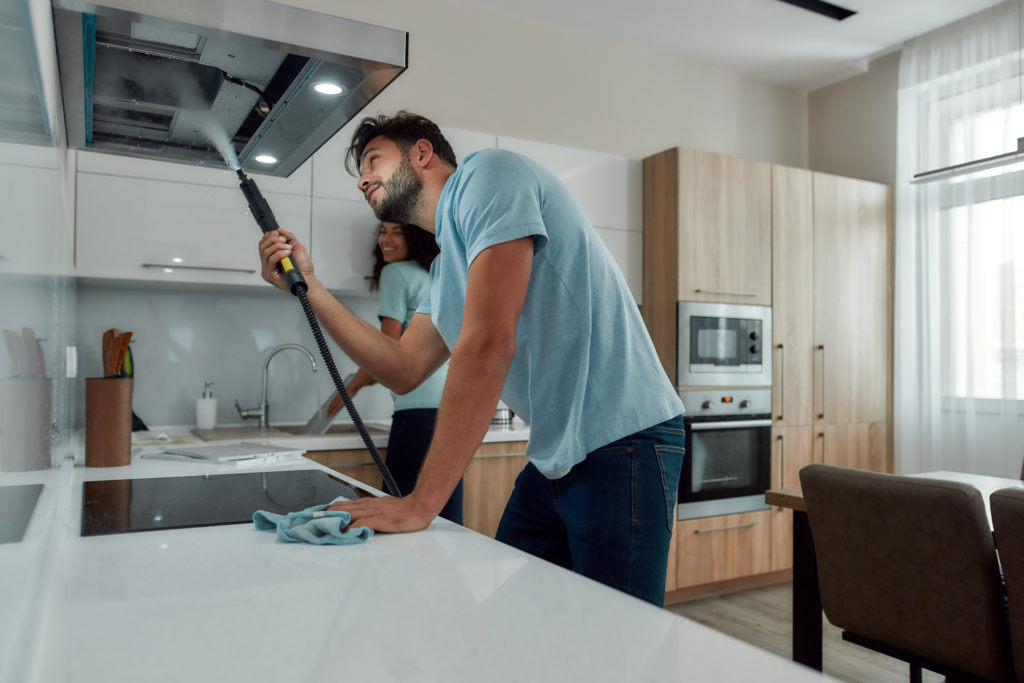
An important part of any kitchen is a well-functioning range hood. This is especially true if you are consistently doing heavy cooking that produces a lot of smoke. Range hoods, also known as vent hoods, come in a wide variety of different sizes, styles, designs, and features. But despite these distinct differences, cleaning and maintaining your range hood is rather similar across the different products and styles.
If you’ve ever shopped for a new range hood, you know that there are many different sizes that come with many different settings. A good rule of thumb is to make sure your vent hood covers at least half of your burners. It should extend along the width of your whole range.
The following seven cleaning and maintenance tips can serve as your go-to guide for your questions about range hood care. Read and implement the following to keep your vent hood running in tip-top shape so that it can do its job of keeping smoke and grease out of your kitchen.
1. Diagnose Range Hood Problems
There are some important signs that will indicate when your vent hood is struggling to do what it is meant to do. It is typical for a vent hood to wear down over time as a result of grease building up or the machinery wearing down from constant use. Make note of the following situations that will tell you it’s time to make repairs or conduct maintenance.
- Smoke is not clearing from your kitchen even when the vent hood is on the highest setting: If this happens, it could be that the duct on your vent hood is obstructed or clogged with grease. It could also be that the fan is not functioning properly due to a greasy or worn-out motor. Finally, the issue could be traceable to the air filter needing to be cleaned or replaced.
- The lights or buttons are not working: These problems could be electrical and can usually be traced to the control board of your vent panel. This kind of problem often requires an expert to come to fix it.
2. Cleaning the Air Filter
The air filter is the part of your vent hood that removes particulates and smoke from the air before pushing it outside of your house or recirculating it. There are two kinds of filters: a metal filter and a charcoal filter. The filters can be easily removed.
- If you have a metal filter, simply remove it, and then put it in a small bin or appropriate container filled with enough degreasing solution to cover the filter completely. Once the grease dissolves, wash It with warm, soapy water. For good measure, put it in the top rack of a dishwasher. Before reattaching it, make sure it is completely dry.
- If you have a charcoal filter, the removal process will be much the same. The only difference is that you can’t clean one of these filters. It is a good idea to replace a charcoal filter annually, or whenever it begins to lose effectiveness.
3. Cleaning the Range Hood Itself
This process is rather simple. Make sure you have the unit turned off and your stovetop is not hot or turned on. A household cleaning spray or degreaser will be perfect for regular clean-ups. Just remember to use a non-abrasive variety. Do not spray the cleaner onto the light bulb or any other electrical components.
4. Cleaning the Vent
You should check the vent leading from your hood to the outside on a regular basis. Grease can sometimes build up in this vent, impairing functionality and potentially causing a fire hazard. If the grease is building up in this part of your vent, it is important to contact a cleaning professional as soon as possible to clean it properly.
5. Cleaning the Fan or Replacing the Motor
The fan motor is generally durable enough that it will not need maintenance, but you should still examine every part of your vent hood when you do check-ups. The motor and bearings can be exposed to excessive humidity and grease. This will cause the range hood not to function properly. A definite sign of this is if the motor is acting up as described in the first tip above. More often than not, it is the blower wheel that has collected dirt and grease. You can remove this part and clean it with a degreaser. If this does not solve your problem, you will most likely need to get the motor replaced.
6. Troubleshooting
A good way to test the vent on your device is to cut a small square of newspaper and hold it over the vent. If the vent hood sucks up the newspaper, you have nothing to worry about!
Every specific model of range hood is unique. If you are having difficulty diagnosing issues on your own, try looking up the model number of your unit. This way you’ll find information about common problems that will occur with your particular model.
By following this advice, you will have a vent hood that lasts a long time and effectively does the job of keeping your kitchen smoke-free and clean.
